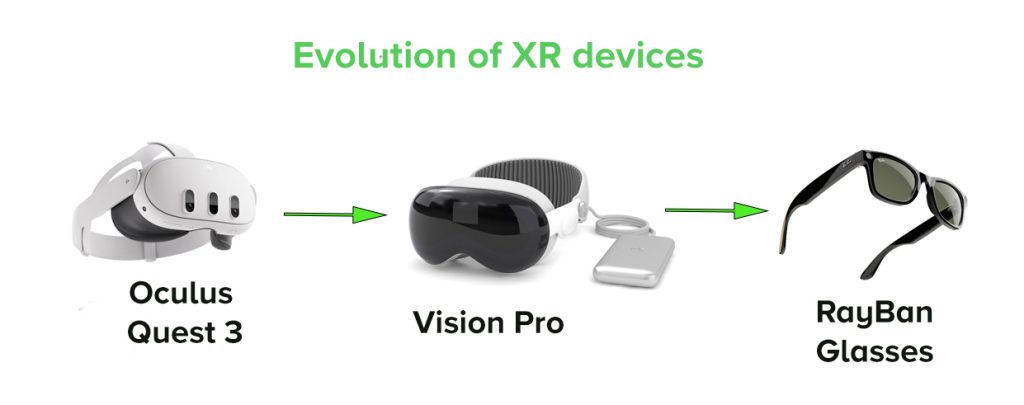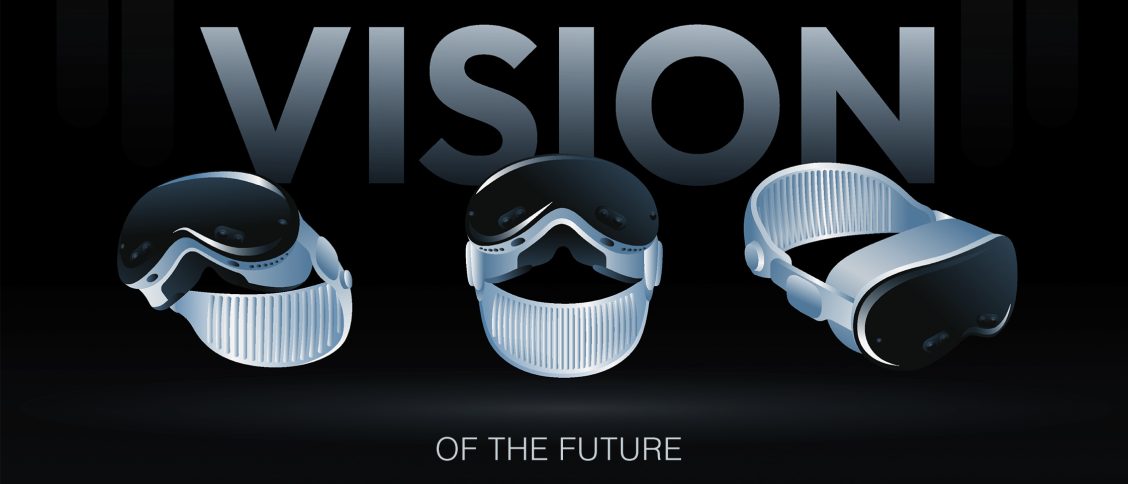I have been in the XR world for a long time and have seen many ups and downs in this technology. I think it’s not an exaggeration, that the most anticipated event in the industry in the last decade was Apple’s entry into the XR market and the announcement of Vision Pro glasses to the public. When the presentation finally took place, industry and market expectations were huge. And as always at such moments – it divided people into two groups. Some thought it was a breakthrough step in the development and adoption of technology, while others approached it with more reserve, claiming that the glasses – despite being technologically advanced – still did not represent expectations. The device is still relatively large, covering a large part of the face and, above all, lacks solid use cases that would make us believe in mass adoption.
This article is not about whether the product is good or bad. It’s about the direction Apple is heading and what is its master plan behind revealing their first XR Glasses – Vision Pro. But let’s not get ahead of ourselves. For now, let’s look at the three players in the race for the holy grail. And in this case, the holy grail it is to reinvent the way we use the artificial world, the future of computing.
Let’s take a brief look at three evolution directions and products (which, in my opinion, are good representants for the categories): Oculus Quest 3, Ray-Ban AR glasses and Apple Vision Pro (which, by the way, doesn’t use any of those terms (VR, AR) but spatial computing.)
Oculus Quest 3,
The first of these products is the Oculus Quest 3, the third generation of VR devices from Meta. The Oculus Quest 3 has significantly raised the bar in VR. I think it’s the best VR device produced so far. It’s light, convenient to use, and they are pushing the bar. I believe in 5-10 years, we will have something ready for mass market. In fact, they made it already marketable. It’s the best-selling headset so far, so it clearly sets them as a leader in the industry. If you are looking for a good and cheap VR device you can’t go wrong with OC3.
(AR) Ray-Ban
Another product in the XR market in 2023 is Ray-Ban AR glasses, a collaboration between Ray-Ban and Meta Reality Labs. These glasses combine Ray-Ban’s stylish designs with AR technology. Ray-Ban AR glasses allow users to use a variety of AR functions, such as displaying route information while cycling, taking phone calls or taking photos. Of course, because of its size – it’s less complex than the other two, but… I mention them for a reason – they represent the ultimate goal in which direction all XR devices must go – light devices which won’t cover the face of the user. I believe this is mandatory for the mass market, and until technology allows us to achieve their size – XR will be a niche product.
Apple Vision Pro
And the last but of course not least – the missing link between those two briefly described above – the Apple Vision Pro. Those glasses result from seven (+) years of research and development. Apple has always been known for its innovative solutions, and its entry into the XR market is no exception. Apple’s Vision offers an augmented reality experience, naturally combining the real world with virtual elements. That’s thanks to advanced motion-tracking technology that allows users to interact with their surroundings at a whole new level (by accurate gestures). Another ground-breaking technology is scanning the eye retina and setting the cursor in the position where we are watching. And it’s unbelievably accurate. So there are a lot of innovations and magic in Apple Vision, which makes them a potential leader in the market – if you are looking for quality and not to attach to your wallet (bit later on that).
The glasses are comfortable, but is the device ready for mass consumption? In my opinion not. But it’s definitely the bold statement from Apple – that they want to be a tech leader again and will reinvent spatial computing or rather make it spatial.
Why did I choose those three? We are still on the road to achieving the consumer product – light glasses which will be the size of Ray Ban AR Glasses but have the functionality of Oculus Quest and Apple’s Vision Pro combined. We need to understand that this is the direction everyone is going and their ultimate first goal; the next could be retina contact lenses or even a direct chip into the brain.

1. Vision Pro glasses are the statement from Apple – that they want to reinvent spatial computing or, better to say, make computing spatial.
The product
If you think of the Vision Pro from the product perspective and marketability – you’re doing it all wrong.
The price tag is $3500. It’s way above the market. But Apple doesn’t want to earn money on it… yet. If you calculate it – the goal for 2024 is to sell 150,000 units of those devices, which gives 525 million; in the scale of Apple’s revenue: 383,29B is a drop in the ocean. Even with 1M of the devices sold predicted for 2025, it’s still <1% of their current revenue. The real money is 10-15 years ahead… in the future when the mass adoption happens.
Product design always has a trade-off between quality and price to make it marketable. The designers of Vision Pro didn’t really pay attention to economy – the glasses look luxurious and are made of HQ materials and aluminium. I believe they want to set the bar higher and hence make another statement: that we should aim for more expensive and better devices since they will replace a computer with time. When I thought more about it, it made sense. XR devices (with some exceptions like Vario) are cheap compared to e,g. the latest MacBook Pro. A perfect example is the first iPhone, which cost 599 dollars, which was 2x the price of regular phones, and still, people bought them. Because Jobs introduced the future to the customers. And in my opinion, Apple wants to do precisely the same – to reinvent traditional computing. To create the next step in our consumption of artificial spheres – and give people another way to interact.
2. Apple want to set the bar higher and make yet another statement: that we should aim for more expensive and better quality devices since, in the future, they will replace a traditional computer.
Swimming against the waves
It’s been 13 years since Apple announced the last new category of devices in their portfolio, and it was the iPad in 2010. Since then, they haven’t innovated, and for Apple, it’s a core value as a company.
Steve Jobs was a visionary, and he was very often on the stump with the shareholders. He had a vision and pursued it against the market and naysayers, but often also sometimes against his employees. Nothing stood in his way when he set his sights on a goal.
Apple is currently sorely lacking this approach, and perhaps the fact that they named the new glasses – Vision says something about it. They want to show the world that after years of doing business (quite successfully), they are back in the game with a new and innovative product that will change the future of humanity.
Apple is not only swimming against the market by presenting a device that is way above the average price of those devices on the market. But they also struggle with technology.
It’s interesting to see Apple’s changing line of narration. Interesting fact: I noticed that they talked A LOT about AR in the last couple of years, but during the reveal of the Vision Pro glasses, they changed narration at some point. I guess that the product is not ready to wear in public, so they changed the way we should think of it: first of all – not using ANY of the XR terms, but also from outdoor to indoor use. I’m pretty sure there was enormous pressure on designers to make it happen (working also outdoors), but it’s a long and challenging way. And everyone familiar with the XR products knows it’s a highly complex matter, and we still don’t have viable technology to create a mass-market product. The problem is light, and conditions outside are much more unpredictable and challenging. And of course, the size of the device, which I described above. No one with common sense will not wear a device that covers half of your face in public.
So, I believe they finally wanted to reveal the product at some point, and they suited narration and presentation to the product in the current development state.
3. Apple changed the narration, first of all – not using ANY of the XR terms, but also they changed use-cases from outdoor to indoor use.
Another argument is that Apple is going against the market, creating expectations, but also against semantics and well-known terms. They want to own their tech and make the customers feel that they are the innovators here. They are so bold that they don’t use terms such: XR, VR, AR or… even AI. Which is unprecedented for any other tech company.
Check this very interesting video of smart tech YouTuber Marques Brownlee. He proves they want the OWN the new sphere. It is a very similar strategy they made with their iOS ecosystem. It’s closed and homogenous, and they never allow other companies to penetrate it. The goal to put the glasses into their hardware portfolio is precisely the same – use a huge client base (many of early adopters) and a vast amount of apps and use the content across all their devices. Bind the user to the ecosystem and make him/her feel at home.
What surprised me most was the lack of solid use cases in Apple’s presentation on Vision Pro. By far the strongest use case was the use of glasses for watching movies and their collaboration with Disney. This makes sense, of course – the two companies share a common past, and Disney is a leader in the entertainment market.
In addition to this, we were shown how to use iOS apps on glasses, and … literally a few seconds were devoted to gaming. For me as a game developer, this was the biggest disappointment. Could it be that Apple has moved gaming as a further part of content development?
My overall impression was as if Apple did not know exactly which direction they wanted to go with their product. And as we know when a product is for everything…. is for nothing. This was perhaps my biggest surprise – the lack of a clear goal for Vision Pro and the strong positioning in the market. I got the impression as if Apple, when presenting the glasses, was not quite sure how to position them (except that it is a premium device.).
4. Lack of strong use cases shows that Apple is not fully confident in which direction they should position the glasses.
Conclusions:
- In announcing its new Vision Pro glasses, Apple made a bold statement that it wants to change the way people use the virtual realm.
- In doing so, they set a long-term goal. They know it is technologically complicated and the technology is not yet ready for it, but they want to lay the groundwork for further development in this direction.
- As a derivative goal, Apple wants to change the way it is perceived. They want to be an innovator, dictate the pace of market development and be a leader as happened during the mobile revolution after the announcement of the iPhone.
- We shouldn’t treat Vision Pro as a product yet. It’s more of a first step in a complex spatial computing ecosystem. There is still a long way ahead of them. But the prize is ultimate – to change the way people interact with virtual space.
As always future will tell. Thanks for reading.




